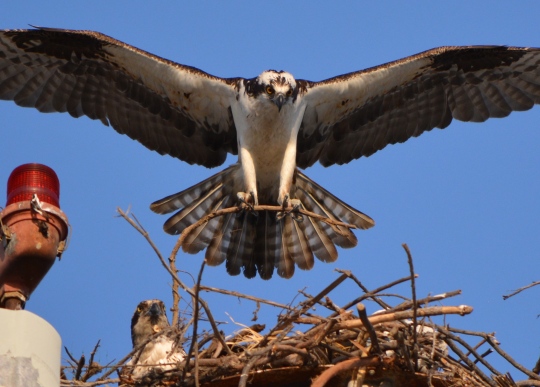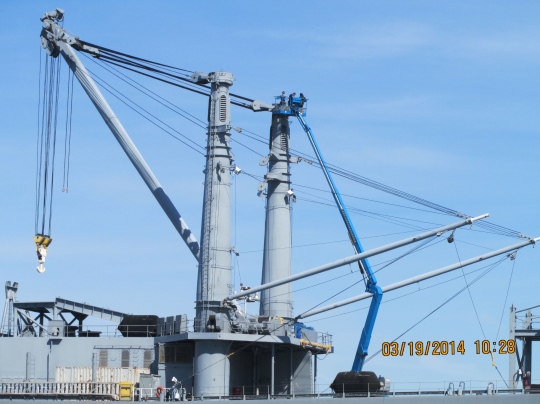Alameda Point Ospreys face nesting disruption
In early June a pair of returning Ospreys looked ready for the day in their newly made nest atop a parking lot light pole at Alameda Point, but they had no chicks to attend to. The pair’s first nest this season — on a nearby ship — had been removed while they were building it. Their second attempt faced interference from another Osprey. By June, hopes for fledglings this year had faded.
An ad hoc group of Osprey watchers is now hoping a dedicated Osprey platform can be erected at Alameda Point in a spot where competing interests and annoyances of daily commotion don’t intrude into the reproductive efforts of the Ospreys.
In early March, the Osprey pair began building their first nest this year where they had nested last year — on a kingpost high atop the maritime ship Admiral Callaghan. The ship’s owner, the Maritime Administration (MARAD), had removed last year’s nest. This year MARAD moved quickly to stop the nest building to avoid potential delay from relocating a nest if the ship were ordered into service.

“The Maritime Administration worked closely with the California Department of Fish and Wildlife on dismantling the nest and installing deterrence devices on March 19 prior to any eggs being laid,” said Alameda resident Harvey Wilson, who has been monitoring the Ospreys at Alameda Point.

But that removal didn’t end the Ospreys’ interest in the ship, at least not for the male Osprey. He soon started bringing sticks to a lower-level hoisting post on the ship. The female, on the other hand, took a liking to a light pole in the parking lot next to the wharf.
After weeks of back-and-forth episodes of mating and nest building at both sites, the female won, and nest building started ramping up on the light pole. At one point, it appeared that the female was hunkering down in the nest, a sign that eggs had been laid and incubation had started. But soon another female Osprey appeared, trying to lure the male from his duties and disturbing the composure of the female.

The third Osprey now seems to have moved on and the original pair has continued to visit the nest, but the lateness of the season offers little hope that eggs will be laid again, if they ever were, this year.

The appearance of Ospreys at Alameda Point, first documented in 2010, is part of alarger Bay Area phenomenon of Ospreys beginning to nest on the shores of San Francisco Bay. Osprey first began nesting in the San Francisco Bay Area in the year 2000, having expanded their nesting range from areas to the north. There are currently 24 active nests on San Francisco Bay.
One theory for the Ospreys’ bayside nesting interest is a reduction of silt in the bay, making it easier for Osprey to catch fish, their primary food source. The high silt levels are a legacy of the gold mining era during which streambeds emptying into the Sacramento River were blasted with water cannons to expose gold particles.
Ospreys normally return to the same nest every year, but the Alameda Point pair has now used three different sites. In 2012 they successfully raised their lone chick on an old light stand on the western jetty of the Seaplane Lagoon, their regular nest for three years. For unknown reasons, they chose the heights of a maritime ship in 2013, and in 2014 the parking lot light pole.

An ad hoc group of osprey watchers that includes members of Golden Gate Bird Alliance has been discussing with the city the possibility of erecting a permanent Osprey nesting platform on the western side of the Seaplane Lagoon.
“City staff has been and is willing to continue to work with interested members of the local community to potentially establish an Osprey platform at Alameda Point,” said Jennifer Ott, Chief Operating Officer for Alameda Point. “The identification of an appropriate location for this platform will depend on a number of factors, including approval by the United States Fish and Wildlife Service.”
In March of this year, the city of Richmond’s Public Works Department assisted with the installation of an Osprey platform at Pt. Molate, which helped divert nesting efforts from a utility pole with live wires. PG&E, with extensive raptor nesting diversion experience throughout California, has offered to install a pole and nesting tub at Alameda Point for free.
“It is difficult to know what the Ospreys feel or how they respond or what their capacity is for all the activity that goes on around them, but this season certainly challenged them,” said Alameda wildlife biologist and GGBA member Leora Feeney. “Providing safe platforms for them outside of busy corridors would serve everyone better.”



